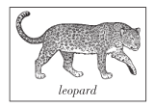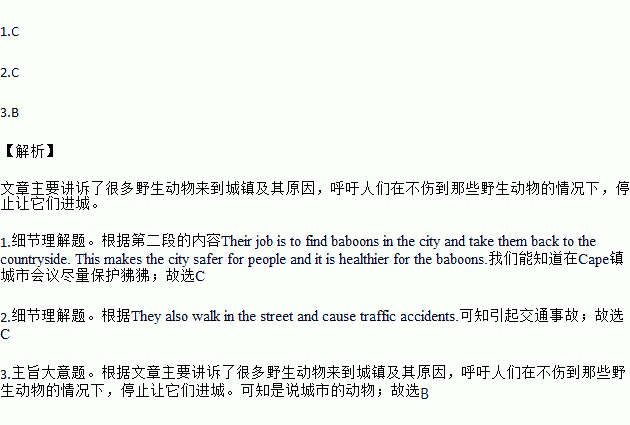题目内容
Recently, there have been many reports in newspapers and on TV about big animals coming into towns and cities. There have been bears in Vancouver parks, leopards on the streets of Mumbai and wild pigs in gardens in Berlin. What happens when big animals come into our cities?

Wild animals usually come into cities to look for food. In Cape Town, South Africa, baboons sometimes eat fruit from gardens and go into people’s kitchens and take food from fridges! Baboons are strong animals that scare children. Many people do not like them, but the city can be dangerous for baboons too. Sometimes, baboons are hurt in car accidents and human food can kill them. The city council (议会) in Cape Town has a team of Baboon Monitors. Their job is to find baboons in the city and take them back to the countryside. This makes the city safer for people and it is healthier for the baboons. The problem is that many baboons will come back to the city to look for food again.

In Berlin, Germany, groups of wild pigs sometimes come into the city to look for food. Pigs have come into the city for hundreds of years, but since the winters are warmer, there are more pigs now than in the past. Pigs eat flowers and plants in gardens and parks in the city. They also walk in the street and cause traffic accidents. Some people like the pigs and give them food. But the city council is worried about traffic accidents. They have told people not to give the pigs food and have put up fences (围栏) to stop the pigs from entering the city.

In Moscow, Russia, there are about 35, 000 wild dogs. They live in parks, markets and train stations. Some of the dogs were pets that people did not want so they left them on the streets. Others were born on the streets and have always lived there. Some dogs live alone and others live in packs (成群). A lot of people like them, and they give the dogs food and water. The winter in Moscow is very cold and people usually offer places for dogs to live in.
For many animals, cities are dangerous places and they need our help to return to the countryside.

1.What can we learn from the second paragraph?
A. Many children like playing with baboons.
B. Cape Town is a safe place for baboons to stay.
C. The city council tried to protect baboons in Cape Town.
D. Baboons were born on the streets and have always lived there.
2.What do we know about wild pigs in Berlin?
A. They make streets dirty.
B. They eat fruit from fridges.
C. They cause traffic accidents.
D. They break fences around gardens.
3.What is the best title for the passage?
A. Animal Protection B. Animals in the City
C. People and Nature D. Food for Animals

